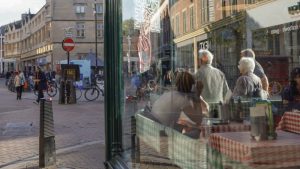how to decorate a brutalist flat
Unlock the Editor’s Digest for free
Roula Khalaf, Editor of the FT, selects her favourite stories in this weekly newsletter.
We are moving into a large flat in the Barbican, having lived in Victorian terraces, an ultra-modern Singapore condo and an early 20th-century mansion flat in Amsterdam. We have furniture from all those places and eras — but how should we decorate our Barbican flat in keeping with the architecture, without “screaming” mid-century?
Wonderful! I enjoy the Barbican, that much-loved and prominent example of British brutalist architecture.
But I have to admit that brutalism is not totally my bag. After all, brutalist buildings are characterised by minimalist constructions that value bare building materials and a monochrome colour palette over decorative design. Red flag! For a devotee of the Baroque, brutalism is in many ways the opposite of all that I love.
However, I have a soft spot for this development, and I very much love commitment to a theme, things done supremely well, and attention to detail. This very special patch of London has attention to detail in buckets.

The Barbican was designed with a new vision for integrating high-density residential neighbourhoods with schools, shops, restaurants and cultural destinations. An article on Houzz notes that “In both the towers and terrace blocks, the layout of the flats was designed to maximise the amount of natural light in the rooms that would most benefit from it. Bedrooms, dining rooms and living rooms are therefore positioned along external walls, while kitchens and bathrooms are placed against inner walls. The generous windows allow light to stream into all areas of the flats.”
I have been lucky to see inside a flat or two. The level of detailing is wonderful to behold: solid timber sliding doors, marvellous handrails, and meticulously designed kitchens and bathrooms.
So how should you go about furnishing your new flat? I applaud your idea of not wanting to scream mid-century. I reckon you’ll be able to mix it up a bit and still create an interior that feels in keeping with the magnificence of the Barbican.

First, I suggest taking a good look at the Barbican flat designed by Maria Speake of Retrouvius. She clad walls and sliding doors with individually scrubbed and hand-sanded pieces of parquet. I love this idea. All that grey brutalist concrete, I would imagine, might leave you feeling a bit cold. Walls of wood bring in warmth. Thinking on a smaller scale, you might want to consider lighting made from wood. I’m a fan of Manhattan’s Blue Green Works: its minimalist Wood Sconce Round is a sculptural delight.
Mid-century design can often suffer from too much sober seriousness, but Speake’s interior is playful. I like her use of colourful antique textiles — on headboards, across beds and under tables. Bright Berber and Turkish rugs add a layer of colour and interest. Speake acquired her textiles from Larusi; I’m drawn to its pile rugs, in particular a vintage Boucherouite rag rug with a bold harlequin pattern.

Next: let’s talk Villa Iolas. When pondering your question, immediately my mind went to the art collector and gallerist Alexander Iolas and his fabulous house in Athens. Born in Alexandria, Egypt, in 1907, Iolas was known for furthering the careers of Max Ernst, Yves Klein and Giorgio de Chirico, among many other artists, and for his decadence.
The severe architecture of Iolas’s villa (hence me thinking of it in relation to the Barbican) played host to a fantastic range of furniture, artwork and decorative objects that could be very inspiring for you. Marble antiquities sat alongside tapestries, antique chandeliers and contemporary artworks. The tension created between this interior assortment and the sharp, clean lines of the villa made the whole package extremely successful.
Milan’s Villa Necchi Campiglio, which now operates as a museum, is another example of a fairly sober building (constructed in the 1930s) that houses an eclectic mix of furniture.

Talking of Milan, I often seem to prefer Italian mid-century furniture over Scandinavian. Consider, for example, something like the walnut and blond wood sofa available from London’s Ebury Trading. Designed by Paolo Buffa, it has been newly upholstered in dusky pink bouclé fabric.
Embrace the sharp beauty of your new Barbican flat, but don’t feel enslaved to the era of its creation. Otherwise I fear you’d end up with a surgery waiting room. Buy an Eames chair if you must, but look to other periods and countries too — and you should certainly incorporate at least a few pieces of furniture from your old homes.
If you have a question for Luke about design and stylish living, email him at [email protected]. Follow him on Instagram @lukeedwardhall
Find out about our latest stories first — follow @ft_houseandhome on Instagram
#decorate #brutalist #flat




